Advertisements
Advertisements
Question
Establish the following vector inequalities geometrically or otherwise:
- | a+b | ≤ |a| + |b|
- |a + b| ≥ | |a| - |b| |
- |a - b| ≤ |a| + |b|
- |a-b| ≥ | |a| - |b| |
When does the equality sign above apply?
Solution
(a) Let two vectors, `veca` and `vecb`, be represented by the adjacent sides of a parallelogram OMNP, as shown in the given figure.
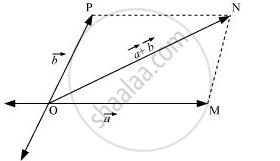
Here, we can write:
`|vec(OM)| = |veca|` ... (i)
`|vec(MN)| = |vecOP| = |vecb|` ....(ii)
`|vec(ON)| = |veca+ vecb|` .....(iii)
In a triangle, each side is smaller than the sum of the other two sides.
Therefore, in ΔOMN, we have:
ON < (OM + MN)
`|veca + vecb| < |veca|+|vecb|` ....(iv)
If the two vectors `veca` and `vecb` act along a straight line in the same direction, then we can write:
`|veca+vecb| = |veca| + |vecb|` ....(v)
Combining equations (iv) and (v), we get:
`|veca+vecb| <= |veca| + |vecb|`
(b) Let two vectors `veca` and `vecb` be represented by the adjacent sides of a parallelogram OMNP, as shown in the given figure.
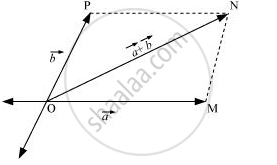
Here, we have:
`|vec(OM)|= |veca|` ...(i)
`|vec(MN)| = |vec(OP)| = |vecb|` ...(ii)
`|vec(ON)| = |veca + vecb|` ...(iii)
In a triangle, each side is smaller than the sum of the other two sides.
Therefore, in ΔOMN, we have:
ON + MN > OM
ON + OM > MN
`|vec(ON)| > |vec(OM) - vec(OP)|` (∵ OP =MN)
`|veca + vecb| > ||veca|-|vecb||` ... (iv)
If the two vectors `veca` and `vecb` act along a straight line in the opposite direction, then we can write:
`|veca+vecb| =||veca|-|vecb||` ... (v)
Combining equations (iv) and (v), we get:
`|veca + vecb| >= ||veca|-|vecb| |`
(c) To prove `|veca - vecb| <= |veca| + |vecb|`
In figure `vec(OL)` and `vec(OM)` represent vectors `veca` and `vecb`, respectively. Here `vec(ON)` represents `veca - vecb`
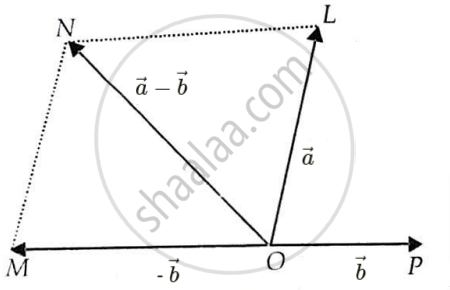
Consider the Δ OMN
ON < MN + OM
or `|veca-vecb| < |veca| +|-vecb|`
or `|veca - vecb| < |veca| + |vecB|` ...(i)
When `veca` and `vecb` are along the same straight line but point in the opposite direction then
`|veca -vecb| = |veca| + |vecB|` ... (ii)
Combining equations i and ii we get
`|veca-vecb <= |veca| + vec|b|`
(d) To prove `|veca - vecb| >= ||veca| - |vecb||`

Let us consider the ΔOMN
ON + OM > MN or ON > |MN - OM|
Since MN = OL
∴ ON > |OL - OM|
or `|veca - vecb| > ||veca|-|vecb||` ...(i)
When `veca` and `vecb` are along the same straight line and point in the same direction then
`|veca - vecb| = |veca| - |vecb|` ...(ii)
Combining equations i and ii we get
`|veca - vecb| >= ||veca| - |vecb||`
APPEARS IN
RELATED QUESTIONS
Given a + b + c + d = 0, state whether the following statement is correct or incorrect:
b + c must lie in the plane of a and d if a and d are not collinear, and in the line of a and d, if they are collinear.
Given a + b + c + d = 0, state whether the following statement is correct or incorrect:
The magnitude of (a + c) equals the magnitude of (b + d).
Given a + b + c + d = 0, state whether the following statement is correct or incorrect:
The magnitude of a can never be greater than the sum of the magnitudes of b, c, and d.
The resultant of two vectors `vecA` and `vecB` is `vecC`. If the magnitude of `vecB` is doubled, the new resultant vector becomes perpendicular to `vecA`, then the magnitude of `vecC` is
For two vectors A and B, A + B = A − B is always true when
- |A| = |B| ≠ 0
- A ⊥ B
- |A| = |B| ≠ 0 and A and B are parallel or anti parallel
- When either |A| or |B| is zero
Given below in column I are the relations between vectors a, b and c and in column II are the orientations of a, b and c in the XY plane. Match the relation in column I to correct orientations in column II.
| Column I | Column II | ||
| (a) | a + b = c | (i) | 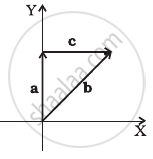 |
| (b) | a – c = b | (ii) |  |
| (c) | b – a = c | (iii) | 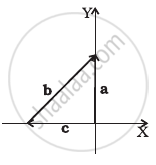 |
| (d) | a + b + c = 0 | (iv) | 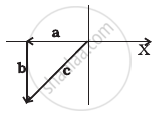 |
If `vecA` and `vecB` is two vectors satisfying the relation `vecA.vecB = [vecA xx vecB]`. Then the value of `[vecA - vecB]` will be ______.
If `vec"A" = (2hat"i"+3hat"j"- hat"k")`m and `vec"B" = (hat"i" + 2hat"j"+ 2hat"k")` m. The magnitude of component of vector `vec"A"` along vector `vec"B"` will be ______ m.
